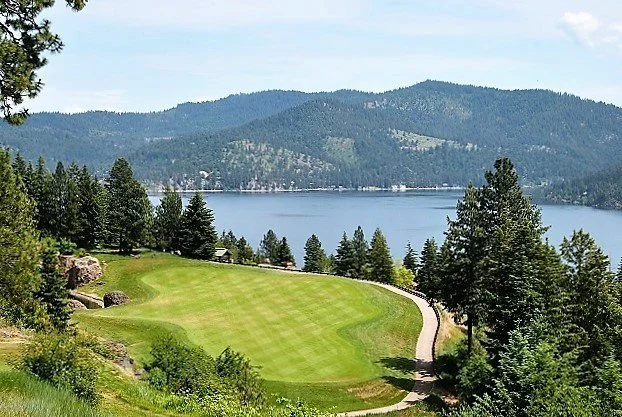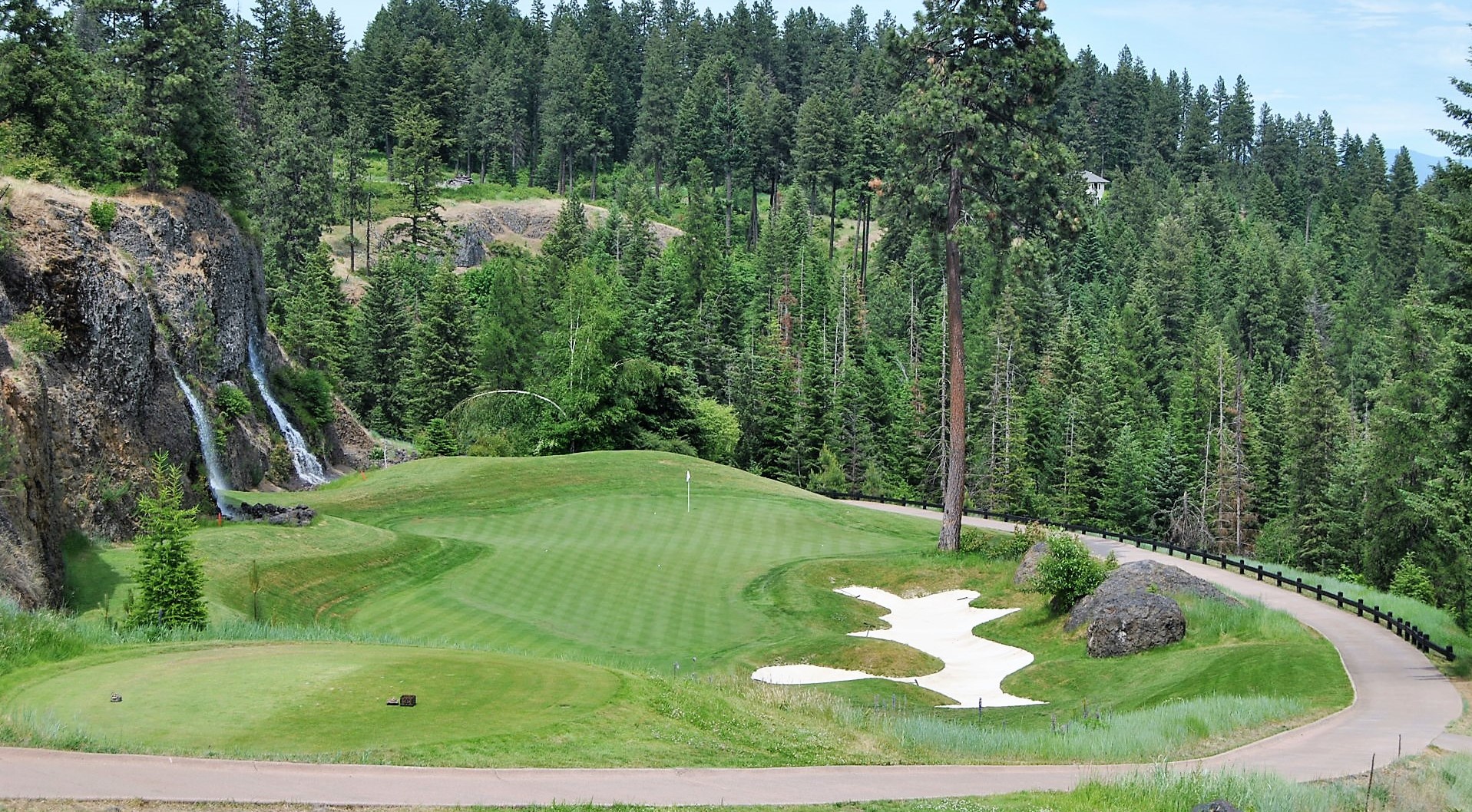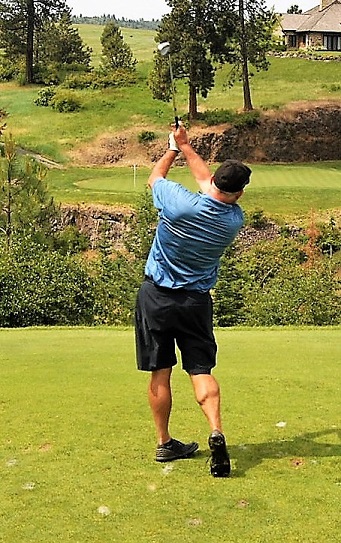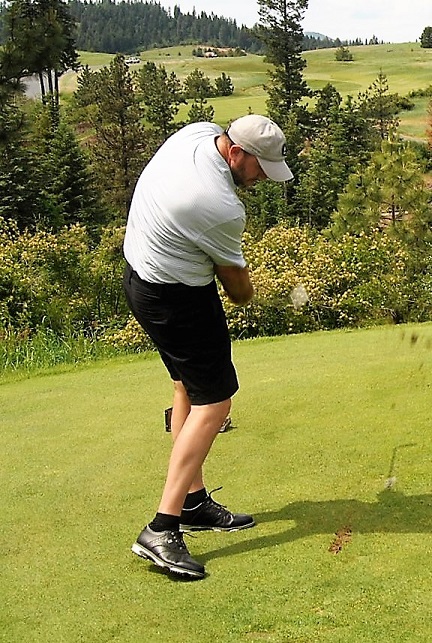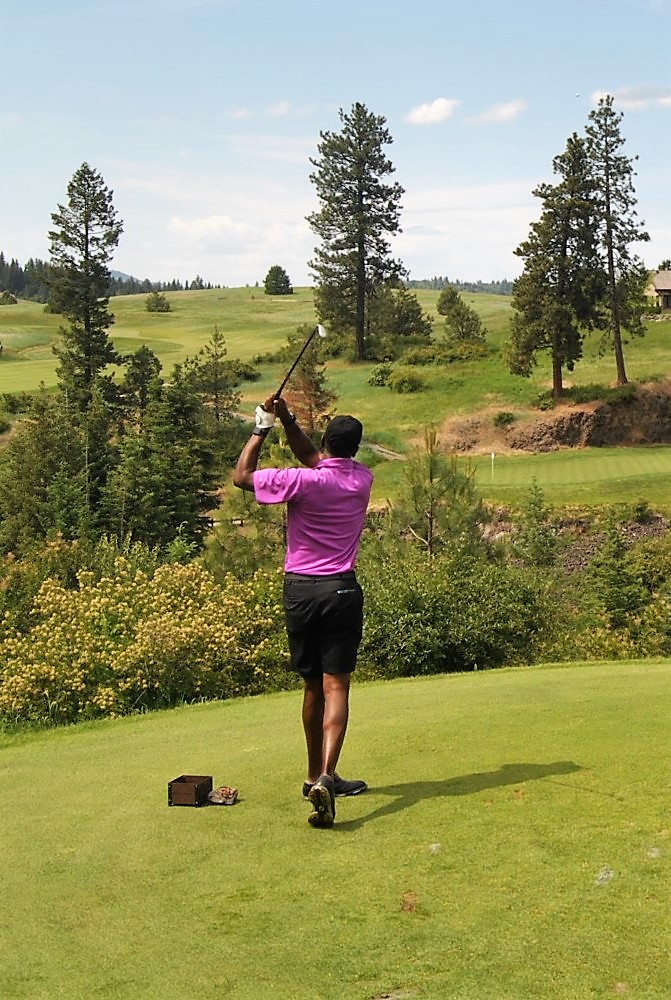The Golf Club at Black Rock
“Look mom, it’s Bill Cosby,” shouted the bright eyed, blonde-haired boy pointing in my direction as I walked the streets of downtown Coeur d’ Alene, Idaho during a sunny day in the late eighties. I’d come to explore firsthand what the Aryan Nation was all about. My curiosity had been spurred by news reports of a gathering of people who harbored extremely hateful views. I wanted to meet these people and ask them why they so loath people who they saw as different. I perused the streets but did not come upon any obvious skinheads, neo-Nazis, clansmen nor anyone else spreading hatred.
During my early boyhood, I experienced deep racism firsthand living in the segregated housing of the Sawmill Quarters in the shadows of Boettcher’s Mill in Huntsville, Texas. The white’s lived at the top of the hill in painted structures with electricity, natural gas, and indoor plumbing. The Mexicans lived in unpainted houses with natural gas but no plumbing. The coloreds, that’s my race according to my birth certificate, lived in the flood prone area at the bottom of the hill in unpainted shacks with neither electricity, natural gas nor plumbing. The floors and walls made from planks cut at the sawmill offered no refuge from the wind and dust which was able to seep through the narrow cracks between them. We sometimes mixed flour with water to make a paste to fill the cracks and block as much of the wind and dust as possible. These tattered structures served as housing for the sawmill workers and their families. The best and highest paying jobs for those workers were held by whites and the more menial lower paying ones were held by the Mexicans and the Colored folks. A few miles away, in downtown Huntsville the water fountains and public bathrooms had signs proclaiming that they were for whites only. As we walked up the hill from our shacks through the Mexican and then White areas, we were pelted with china berries propelled from what they called “nigger shooters,” more commonly known as slingshots. If this type of racism was in Coeur d’Alene, Idaho in the late eighties, it and those who perpetrated it had retreated to their dark and evil places by the time I arrived.
My return to Coeur d’ Alene was for a much more pleasant endeavor. Just four courses stood between my dream and a delusion. If I could play The Golf Club at Black Rock, Gozzer Ranch and Golf Club (both in Idaho), the Ocean Course at Kiawah Island Resort in South Carolina, and Wade Hampton in Cashiers, North Carolina it would serve as proof to my kids that while our country still has challenges living up to our highest aspirations, we have made progress and our links remain unbroken as a nation of people who help each other achieve our dreams. If I couldn’t finish those four courses in the ensuing six days, my quest would have turned out to be the delusion that some suspected all along.
I met Sean Ogle while exploring different avenues for gaining access to the country’s most exclusive golf and country clubs. We shared our golf dreams with each other. He wanted to play the top 100 courses in the country before turning 35. After reading one of my email updates during the final months of my quest, he reached out and offered to introduce me to someone who could host me at Black Rock. Bob was all in from the moment he got the introductory email from Sean. Not only did he agree to host me at Black Rock on one of the few remaining days that I had open on my schedule, he also committed to asking a family friend to host me at Gozzer Ranch.
I arrived in Coeur d’ Alene the afternoon before my round at Black Rock and drove through the area to take in the beautiful mountains and valleys around Lake Coeur d’ Alene. As I groveled at the majestic scenes, I thought back to Tom Landry’s(legendary Dallas Cowboys head coach and all around standup guy) words to me decades earlier while driving him through the rolling hills of North Virginia when I was a field associate for the Fellowship of Christian Athletes. Tom said, “I can’t believe God didn’t put this in Texas.” Whether it was the mountains in places like North Carolina, West Virginia, Pennsylvania, and Colorado, the coastlines of California and Oregon, the quaint towns in the Northeast, the Florida everglades, the shores of Lake Michigan, or the numerous other beautiful places that my dream had taken me over the last twelve months, I came to understand that God didn’t put it all in Texas because he could only make it so big.
Bob, with what appeared to be a freshly grown beard, was sitting at a table in the men’s locker room finishing his breakfast as I walked up and introduced myself. A commercial real estate developer, he was also wrapping up some work. Moments later his brother Mike, a police officer from Phoenix who looked nothing like Bob, walked in. We exchanged pleasantries and chatted about our upcoming round before heading to the practice range where I met Cody and Pat, who like Mike were public servants. They were both firemen. The retired oil executive, the real estate developer, the policeman, and the two firemen all tossed a golf ball in the air to see who the first wolf would be. On each hole the wolf would decide whether to go it alone or choose one of the other golfers as a partner to challenge the other players for the best score on the hole. The wolf must decide whether to choose the player immediately after that player hits his tee shot. The golfer who accumulates the most points during the round, wins the bet. Points are determined by how each golfer scores relative to the other golfers on each hole. It was a way to add a little pressure during the round. However, with my picture and note taking, I couldn’t pay much attention to who was partnered with whom on which hole nor who was winning what.
The pine trees lining the sides of the fairway on the 339-yard first hole looked tiny against the big sky with its scattered clouds. I ripped my tee shot down the middle of the fairway with a three wood. It always felt good to get that first one in the fairway. Bob was the first wolf. He picked me as his partner.
The pin was 130 yards away just left of the lone bunker sitting off the front of a wide but shallow green. I laid down the marker with my approach shot, hitting my pitching wedge to 8 feet left of the hole. The day of rest had paid off. I was pain and tension free.
A birdie after two solid swings would be a perfect way to start my first ever round of golf in Idaho. It was not to be as the ball slid by the hole, but I felt good about the solid start. Everyone but Mike also parred the hole, but I had no idea who got how many points.
The small pond covered with colorful wildflowers and just off the front of the tee boxes was so far from the large green with the pin set dead in the middle, that topping the ball or popping it straight up would be the only way to bring it into play. I did neither. With the 170-yard downhill par three playing just 160 yards, I hit my seven iron to six feet right of the flag. Oh yes, after 96 courses, over 80,000 miles, and 360 days, I could still occasionally muster an A game.
I tapped the ball and watched as it rolled down the slight incline and into the center of the cup. Birdie. Cody and Mike made pars, but since Cody got a stroke, he scored a net birdie to tie me on the hole.
The fairway on the 578-yard par five third hole was curved between sloping hills as it seemed to flow over cascading levels toward the distant mountains. Bob tried to tell me where to drive the ball to position it for my second shot. I didn’t quite understand what he was saying. A little confused, I didn’t commit to the swing and pushed the ball to the right. It landed on the slope to the right of the fairway leaving an awkward stance.
I never got my footing on the hole. It took four additional swings to reach the green. I was fortunate to limit the damage to a double bogey. I walked off the green thinking about how an A game includes sound thinking and prudent risk taking, not just a relaxed swing. Mike was the only one to avoid a double bogey. He got the most points on the hole.
Looking down upon a narrow fairway as it wound its way between the bunkers off its left and right sides, rising and falling with the rippling contours of the ground beneath it, I couldn’t see a green anywhere in sight. Bob said, “the fairway bends to the left. The green is off the bunker at the bottom of the slope on the left side of the fairway.” The hole measured just over 360 yards, but Bob said I still needed a driver to clear the bunker and reach the wide part of the fairway. My drive landed in the fairway just past the end of the bunker leaving 130 yards to the flag.
As Bob watched my approach shot sail right, he said, “there’s a hazard over there.” My ball landed just to the left of it and short of the narrow but long green.
I pitched on to three feet left of the flag and sank the putt to save par. Bob matched my par. Still focused on taking notes and pictures, I had no idea where we stood on points.
The fifth hole is the shortest of the five par 5’s on the course, measuring just 494 yards. Bob explained that the distance was misleading because unless you are capable of a 300-yard drive that carried to where the fairway ran out on the right, you’d still have to lay up on the second shot because of the water and the angle. I hit my drive to the middle of the fairway leaving 260 yards to the green and two shots to get there.
To avoid the bunker on the left, I laid up to the right side of the fairway. It made for a longer approach shot but eliminated the risk.
I still however had to hit over the bunker to reach the flag. From 110 yards out, I hit my sand wedge to 25 feet right of the flag.
Two putts and another par which this time was matched by Bob. While I wasn’t tracking the points, I had a suspicion that with everyone but me getting strokes, I wasn’t racking up many points.
The shortest par five on the course is followed by the longest par four on the front nine. The sixth hole measures 404 yards as it runs along a lake off the right of its fairway which narrowed significantly at about 300 yards from the tee. I delivered another drive down the middle leaving 150 yards, most of which were along that narrow strip sandwiched between bunkers and water to the right and rolling hills to the left.
To avoid hitting over the water and the sand, I took an extra club, started the ball left of the flag and let it fade back to the right as it approached the green. The shot would have been perfect had I not used the extra club. The ball carried long. It landed on the back of the green before running up the rising slope just beyond the green.
I struck the ball with the toe of my putter to get it rolling down the slope and onto the green. Unfortunately, I didn’t strike it with enough force. The ball stopped ten feet from the hole, and I missed the par putt and settled for a discomforting bogey allowing Mike who had partner with Bob to win the hole and the most points.
The green on the 194-yard par three seventh hole is called Shamrock with its clover leaf shapes that formed around long bunkers that look like a stem off the front of the green. The pin was set in the middle of the green directly behind the bunker. I drew my tee shot around the bunker but again hit way more club than I needed. The ball rolled off the back of the green and up the slope.
I chipped the ball to 15 feet. It stayed on the higher tier leaving a fast, downhill putt for par.
I started my putt on the intended line and thought I’d made it, but just as the ball approached the cup it made a surprise break to the left. Bogey.
The par five eighth hole with a fairway that winds through the trees and along the water off to the left as it approaches the green is made more scenic by the mountains in the distance. The downhill hole measures 567 yards. I pounded a drive down the right side of the fairway. The ball easily carried the bunker at 200 yards off the tee but didn’t stay in the air long enough to carry the ten yards of rough that wrapped around the bunker.
I popped the ball up on my second shot leaving 150 yards from the left rough to the green. My highest priority on the third shot was to land right of the pin to take the water and the numerous bunkers off the left side of the green out of play. I pulled the ball, it landed on the green but left of the flag.
My birdie putt sped by the hole, but I made the comeback for par.
A par on the 172-yard par three ninth hole with its kidney shaped green and I would break 40 on the front nine. As we approached the tee box, we were joined by Jim Engh, the course designer.
Perhaps it was having Jim watch as I hit my tee shot or my thinking about my score. Either way, I hit one of my worst shots of the day off the tee. The ball landed in the rough well short of the green. I pitched on leaving a tricky right to left breaking downhill putt.
I gave the ball a gentle nudge hoping gravity would take over from there. The ball somehow managed to stop halfway to the hole. I missed the next putt and recorded a double bogey for a 41 on the front nine besting Bob by one stroke. I still had no idea what that meant in terms of our bet.
Jim sped ahead as we drove to the short but scenic tenth hole. The hole measures just 351 yards but plays less with its elevated tee box perched above the doglegged left fairway that slides between the pine trees. Bob said, “the ideal shot is a 220-yard carry over the bunker cutting into the right edge of the fairway.” I followed his instructions and hit my three hybrid to the fairway leaving 148 yards to a back pin.
Natural views on a golf course don’t get much better than the one I took in as I stood over my ball preparing to hit into the 10th green. The tall pines on each side of the fairway perfectly framed Lake Coeur d’Alene and the distance mountains rising behind it. I glanced up too soon during my swing and hit behind the ball. The ball flew directly toward the pin but fell well short of the green.
I pitched on to 30 feet below the cup. With Bob assisting me on the read, I sent the ball rolling on the line he pointed to. It dropped into the cup to save par.
With the lake now right in front of us. I caught a glimpse of a waterfall out of the corner of my left eye. Bob said, “you need to land your ball short of that waterfall, there’s another to the left of it. The green is between them.” I imagined the setting had to be spectacular. “Hit the same club you hit on the last hole and you should be fine.” I hit my three hybrid down the middle of the fairway.
We drove to my ball. I could now see both waterfalls cascading over the large rocks into the small pool in front of a green that looked like it had been carved out of the hillside. I stared at the pin 130 yards away and took dead aim before swinging the club. The ball flew over the flag and dropped nine feet behind it.
Bob took care to give me a good read. I pushed the ball toward the cup with my putter. It held its line as it closed in on the cup.
My body remained frozen as I turned my head and watched the ball drop for my second birdie of the round. It was high fives all around as we gave Bob his props for giving me the perfect read. On the eleventh hole of my 97th course, that birdie symbolized the golfer’s creed and the American Dream. Yes, we live in a country where we can celebrate selflessly helping another achieve his or her dream. Bob and I were competing against each other, yet he used his knowledge of the course to give me guidance on the tee shot and the putt. The birdie went on my scorecard, but it was a team effort. We can be competitors without being adversaries.
My joy was short-lived. I topped my drive sending the ball into the deep rough just beyond the tee boxes on the 538-yard par five twelfth hole cut into the slope along the shore of the lake. Best I could do was the pitch out to get the ball back in play.
We caught up with Jim Engh again in the fairway. I was looking at my fifth shot as the white flag blew in the breeze 170 yards away. I looked at Jim and asked, “what do you think, should I hit my 170 club or my 180 club?” He said, “Hit the 180 club. Most amateurs hit their clubs shorter than they think.” I took his advice. My ball flew over the flag, landed 10 yards past it and rolled into the fringe. Jim looked back at me and said, “hmm, I guess you’re not most amateurs.”
I two putted for my second double bogey of the day, both on par fives.
Jim remained with us as we headed to the short par three thirteenth hole with water cascading down the cliffs to the left and a long wiggly bunker off to the right. I told Jim that I was in search of a hole-in-one and asked where and how far I should hit my tee shot.
The hole measures 138 yards to the middle of the green but plays downhill. With the flag pushed toward the back of the green, Jim said “today it’s playing the number, land the ball just beyond the ridge running across the green and to the left of the flag.” My ball flew on that line but landed short of the ridge leaving a tedious fifty-foot putt.
With a desire to get the ball to the hole, I struck it too hard. The ball raced six feet past the cup. My next putt was as timid as you would expect after the previous strongly hit putt. The ball stopped short of the cup leading to a very disheartening bogey. Jim tried to console me my saying, “don’t worry, you will have another chance at the next hole.”
The fourteenth hole was set up for an even easier opportunity to grab that elusive hole-in-one. The pin was set on the left side of a long but shallow green with a ridge running down the middle. The hole played just 145 yards over a deep ravine. Jim said, “hit the ball to pin high on a line splitting those two trees behind the green and the ball should roll down to the cup.” I struck the ball along what looked like the perfect line. It landed on the green pin high but two yards right of the slope. It stopped dead leaving another fast putt down the slope to the cup.
I listened intently to Jim as he gave me guidance on my putt. I put just enough into the ball to get it to the edge of the slope and watched it roll wide of the cup. I missed the cup by about as much as I’d missed my mark on the ridge but made the five-footer to save par. Jim’s work was done, he’d given me good advice on the two back-to-back par threes’. I’d failed to execute and was now out of hole-in-one opportunities at Black Rock. Jim headed back to the clubhouse as the rest of us drove to the fifteenth tee box.
The long 417-yard fifteenth hole is about as wide-open a hole as you will find at Black Rock. There wasn’t a single tree on the hole, just small mounds rising and falling along the right side of the right to left bending fairway. My drive landed in the right side on the fairway.
I tried to draw the ball along the contour of the ever-narrowing fairway but hit the inopportune straight ball. The ball landed to the right of the green. I pitched on from the fescue to ten feet past the pin.
My par putt missed the cup. I tapped in for a bogey.
There are more than a few holes among the 100 Greatest Courses in America that have the potential to strike fear in every recreational golfer. Holes like the par five sixth hole at Pebble Beach, the par three eleventh hole at Shinnecock, and the par three seventeenth hole with its island green and on the TPC Sawgrass Stadium Course. I think you can put the 529-yard par five sixteenth hole at Black Rock in that category.
I surveyed the hole from my vaulted perch above the fairway but couldn’t for the life of me figure out how I was supposed to play the hole. I could see the fairway end just short of a lake and then appear to continue past several trees and to the right of the lake. While Jim Engh had left us, I was fortunate to still have Bob to guide me. He said, “you need to get the ball to just past that lone tree off the right side of the fairway just before it ends.” He told me that if I hit the ball to there and it rolled to the end of the fairway, I might have chance of hitting over the lake and reaching the green in two.
My ball sailed farther right than I had intended, landing in the rough to the right of the tree rather than in the fairway to the left of it.
With the green over 220 yards away, a ball that didn’t float and the absence of the ability to walk on water, I thought it best to lay up rather than risk going for the green. I hit my pitching wedge to just short of the water, leaving 95 yards to a front middle pin.
My third shot soared high over the lake and then over the flag before landing on the slope behind the hole. It then rolled back down the slope before stopping five feet short of the hole.
Bob had given me excellent reads on my two prior birdie putts. While my ball was less than two paces from the cup, I still asked for his help with the line. He walked behind the green, took a look and then pointed to the line. My ball rolled along the line and dropped in the cup for my third birdie. It was my most satisfying of the three since it was on the second most difficult and the scariest hole on the course. I couldn’t wait to see Jim again to tell him that I’d birdied the hole.
My next challenge was to avoid, another PBFU. I’d made double bogeys following my two previous birdies on difficult holes that followed. The 332-yard seventeenth hole is one of the easiest on the course, but I have a history of playing poorly on short holes. Jim’s design of the hole made the decision on what to hit off the tee very easy. There are thirteen small unlucky bunkers that start about 240 yards from the tee and end about 90 yards from the green. A 210 yards shot would leave me short of the bunkers and at my gap wedge distance. I struck the ball with my three hybrid and sent it down the middle of the fairway. It rolled out, leaving just 110 yards rather than the 120 yards I was aiming for.
I tried to take a little off my gap wedge as I struck the ball. The ball still sailed past the flag and onto the hill behind the green. Fortunately, it kicked back onto the green and rolled to twenty feet.
Bob gave me another great read. My putt held its line but stopped six inches from a fourth birdie. I tapped in for par feeling relieved to have avoided the dreaded PBFU.
Black Rock finishes with a 396-yard par four. Its telescoping fairway provides lots of room for landing the ball on the drive but narrows continuously as is winds between mounds and bunkers off both sides in route to the final green.
It was one of my worst drives of the day. The ball came out low and curved to the right landing and nestling down into the thick rough.
My second shot wasn’t much better, the rough grabbed and closed the club s. The ball hooked into the bunker off the left side of the fairway leaving 90 yards and an awkward stance and blind shot to the green. Making it worse was learning that hitting into the bunker cost me all the money I’d made during the round from my three birdies. I never quite understood the bet, but it looked like I might end up on the short end.
The shot from the bunker flew farther right than I’d expected and almost landed in the bunker just short of the right side of the green. I’d had a good round but wasn’t closing the deal. One thing I learned selling encyclopedias during my late teens was once the sale was made, I needed to get out of the house. I’d made the sale with three birdies but was still on the course and it was inflicting a little bit of pain before bidding me farewell.
I chipped onto the green and two-putted to finish with a 40 on the back nine and an 81 for the round. My wallet was a few bills lighter, but it was worth it and all in fun.
Following the round, we gathered at the pool where I saw Jim again and was introduced to several other members of the club. Bob’s, Cody’s, and Patrick’s wives, Kelly, Katie, and Katie and their kids joined us at the pool. Yes, there are two Katie’s. Mike’s wife, Elisa was back home in Arizona. It was a nice end to a fun day with a good group of people. People that make up the threads that when woven together with the many other folks I met along the way, create the fabric of America. I’m not sure who those people were who sported skinheads, swastikas and other symbols of racism and hatred that I come to Coeur d’Alene in search of three decades earlier, the people I spent time with, in Coeur d’Alene on this trip were nothing like those people. I walked away from Black Rock with new friends and an invitation from the staff and several members to return at any time. Bob even said his house was open to me and my wife whether they were in town or not. We don’t hear too much about this version of America these days, but it is certainly a part of the America I experienced during my quest.

